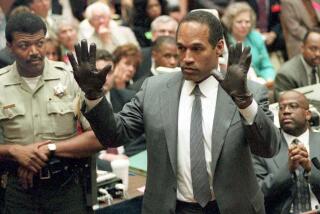Separating Message From Medium in Sweeps Month
Television news breeds cynicism. The savvy audience watches self-serving features and sensationalistic ratings-period stories and begins to question the motives behind almost every story.
Monica Gayle doesn’t deserve such cynicism. Last week, the KNSD-TV (Channel 39) anchorwoman stepped into the midst of a competitive ratings sweep period and, in an interview with reporter Rory Devine, told viewers about how she was raped three years ago in Denver, where she was working. It was a touching, poignant, extremely personal story.
If phone calls to The Times and newsroom discussions are any indication, the story elicited a wide range of response, testimony to the power of Gayle’s tale.
Many had nothing but praise for Gayle and the guts she displayed in coming forward. Others, although not condemning Gayle, questioned the station’s handling of the story. They called it a cheap, ratings-period exploitation. “What makes Gayle’s story different from those of thousands of other women who are raped?” they asked.
Such accusations are unfair to Gayle. No amount of money or ratings pressure could force a woman to do what she did. Period.
The station, however, leaves itself open to charges of exploiting Gayle, of using her to attract ratings.
It was shown during a sweeps period. Nothing wrong with that. In television news, if a station has a dramatic story, it will naturally run it during a time when it can do the most good, just as a newspaper runs a big story on Page 1.
But television’s track record of exploitation and sensationalism lends credibility to such charges, even when the topic is worthy. Tales of true crime and society’s quirks are popular ratings period fodder--gay marriages, greedy evangelists and drunk drivers have been among the local topics this November. Channel 39 did a feature on date rape in July, the last sweeps period.
In the realm of television news, Channel 39 showed admirable restraint on the Gayle story, which was part of a series on rape. There was no cheesy re-creation of the attack or exploitative close-ups of Gayle’s tears. Yet, the station did push the story into the realm of dramatics by showing the seemingly obligatory scene of Gayle sitting on the beach looking contemplative to promote it.
Channel 39 would have been less vulnerable if the multi-part feature on rape had been more fully developed. Gayle was featured for two nights. Instead of being part of the story, she became the story. Devine introduced Gayle with, “You know her as a professional, competent journalist.”
Gayle was accorded the type of treatment the average rape victim wouldn’t get from a news operation. She had full control of the segment.
“I appreciate the station’s sensibility and willingness to give me that control,” she said. “It’s important that people see me as a human being. But they also need to know that I’m in control and here doing my job and not falling apart at the seams.”
The importance of Gayle’s story is unarguable. Much like Magic Johnson’s stunning revelation (made a few days after Gayle taped her interview), Gayle’s report put a very human face on a tragic social problem.
“It reaffirms that it can happen to anyone, and I think that’s an important message,” Gayle said.
She told her story because she wanted to try “to make something positive” out of the horrible experience. She said she didn’t feel exploited.
“The timing . . . wasn’t perfect, but you have to tell the story when you feel compelled to tell it,” Gayle said.
Her revelation was not without precedent. A few months ago, KGTV (Channel 10) reporter Marti Emerald acknowledged during a commentary that she had been raped when she was younger. As Gayle pointed out, such personal stories from television news people, who, for better or worse, are high-profile personalities, carry tremendous emotional weight in the community.
But television news has always had a problem separating itself from the news, distinguishing self-promotion from journalistic detachment. It’s part of the modern reality of television news. Of course they are going to promote the story and milk it for all its worth. Of course they are going to use it during sweeps.
That doesn’t make it any less cheesy. But, in the case of Gayle’s story, it’s also important to separate the message from the medium.
Confirming what many listeners viewed as inevitable, KGB-FM (101.5) is now calling itself “Rock ‘n’ Roll Classics,” dropping any pretense of playing current rock hits.
In the face of increased competition from KSDO-FM (Classic 103) and KIOZ-FM (Rock 102), KGB has been retrenching, growing more conservative for the past two years. Once a dominant album oriented-rock (AOR) station, KGB moved to the safe ground of proven hits, as its market share gradually diminished.
“This is not 1984,” said KGB general manager Tom Baker. “You have got to define what you are.”
The age of “niche programming”--programming targeting specific audience segments--has arrived, according to Baker. Advertising executives drool over the money-spending 25-54 age group.
“It’s the biggest lump of the population, and I want it,” Baker said.
Some in the industry were surprised that KGB deserted its younger listeners, that it was unwilling to target the next generation of rock fans. But Baker says his station’s research--yes, the omnipotent research--says that it is not going to lose its young audience.
“Somebody who is 17 years of age and likes classic rock is going to listen,” Baker said. “If they’re 17 and like Metallica, they weren’t going to listen anyway.”
Always looking for new ways to expand its audience in an age of increased competition, KGTV (Channel 10) has entered into an agreement to simulcast its 5 p.m. newscast on KCEO-AM (1000), beginning today. . . .
Adams Communications boss Jim Seemiller has brought in Dave Siebert from Adams’ Phoenix station to be general manager of KCBQ, and Seemiller is vowing to be less involved in the station’s day-to-day activities.
More to Read
The complete guide to home viewing
Get Screen Gab for everything about the TV shows and streaming movies everyone’s talking about.
You may occasionally receive promotional content from the Los Angeles Times.






